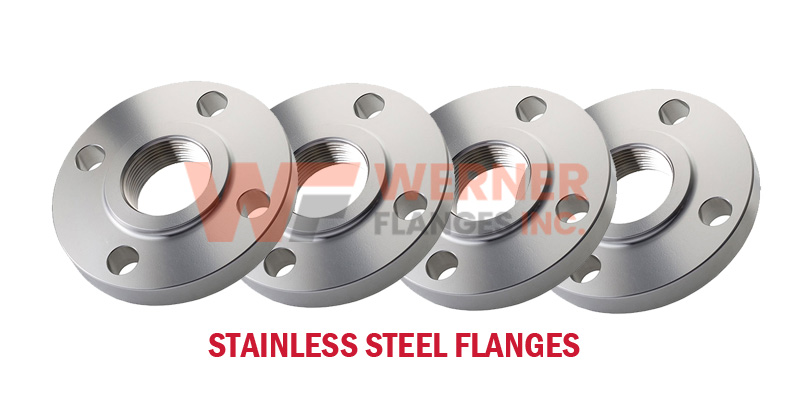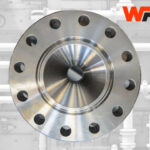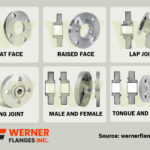Stainless steel flanges are essential components in various industries, including oil and gas, chemical processing, water treatment, and food production. These flanges are used to connect pipes, valves, pumps, and other equipment to form a piping system. They provide easy access for cleaning, inspection, and modification, making them indispensable in many applications. This article delves into the world of stainless steel flanges, exploring their types, applications, benefits, and considerations for selection.
What Are Stainless Steel Flanges?
Stainless steel flanges are disc-like components that are used to connect pipes, valves, and other equipment in a piping system. They are typically welded or screwed into the pipe and then bolted together with gaskets in between to create a seal. The primary purpose of a flange is to provide a secure and leak-proof connection between two sections of a piping system.
Stainless steel, as the material of choice, offers excellent corrosion resistance, high strength, and durability, making it suitable for a wide range of environments, including those with high temperatures, pressures, and corrosive substances.
Types of Stainless Steel Flanges
There are several types of stainless steel flanges, each designed for specific applications and requirements. The most common types include:
1. Weld Neck Flanges (WN)
Weld neck flanges are characterized by a long tapered hub that provides reinforcement and strength to the flange. They are typically used in high-pressure and high-temperature applications. The tapered hub allows for a smooth transition of stress from the flange to the pipe, reducing the risk of failure.
2. Slip-On Flanges (SO)
Slip-on flanges are easy to install and are slipped over the pipe before being welded in place. They are suitable for low-pressure applications and are often used in systems where frequent disassembly is required.
3. Blind Flanges (BL)
Blind flanges are used to close the end of a piping system or vessel. They do not have a bore and are typically used for testing or isolation purposes. Blind flanges are available in various sizes and pressure ratings.
4. Socket Weld Flanges (SW)
Socket weld flanges are used for small-diameter pipes and high-pressure applications. The pipe is inserted into the socket of the flange and then welded in place, creating a strong and leak-proof connection.
5. Threaded Flanges (TH)
Threaded flanges are similar to slip-on flanges but have threads on the inner bore, allowing them to be screwed onto the pipe without welding. They are commonly used in low-pressure applications and in systems where welding is not feasible.
6. Lap Joint Flanges (LJ)
Lap joint flanges are used in conjunction with a stub end. The flange itself is not welded to the pipe but is instead bolted to the stub end, allowing for easy alignment and disassembly. They are often used in systems that require frequent maintenance.
7. Orifice Flanges
Orifice flanges are used in conjunction with orifice meters to measure the flow rate of liquids or gases in a piping system. They have a pair of pressure tap holes that allow for the installation of an orifice plate.
8. Spectacle Blinds
Spectacle blinds are used to isolate sections of a piping system. They consist of two metal discs connected by a handle, with one disc being solid (blind) and the other having a bore (spacer). They are used to ensure that no flow occurs through a section of the pipe when the blind is in place.
Applications of Stainless Steel Flanges
Stainless steel flanges are used in a wide range of industries and applications due to their versatility, durability, and resistance to corrosion. Some of the most common applications include:
1. Oil and Gas Industry
In the oil and gas industry, stainless steel flanges are used in pipelines, refineries, and offshore platforms. They are essential for connecting pipes and equipment in high-pressure and high-temperature environments, where corrosion resistance is critical.
2. Chemical Processing
Stainless steel flanges are widely used in chemical processing plants, where they are exposed to corrosive chemicals and high temperatures. Their resistance to corrosion and ability to withstand harsh conditions make them ideal for this industry.
3. Water Treatment
In water treatment facilities, stainless steel flanges are used to connect pipes and equipment that transport and treat water. Their resistance to corrosion and ability to handle high pressures make them suitable for this application.
4. Food and Beverage Industry
Stainless steel flanges are used in the food and beverage industry due to their hygienic properties and resistance to corrosion. They are commonly used in pipelines that transport food products, beverages, and dairy products.
5. Pharmaceutical Industry
In the pharmaceutical industry, stainless steel flanges are used in the production and transportation of drugs and other medical products. Their ability to maintain a sterile environment and resist corrosion is crucial in this industry.
6. Power Generation
Stainless steel flanges are used in power plants, including nuclear, coal, and gas-fired plants. They are essential for connecting pipes and equipment in high-temperature and high-pressure environments.
7. Marine Industry
In the marine industry, stainless steel flanges are used in ships and offshore platforms. Their resistance to corrosion from saltwater and ability to withstand harsh marine environments make them ideal for this application.
Benefits of Stainless Steel Flanges
Stainless steel flanges offer numerous benefits, making them a popular choice in various industries. Some of the key benefits include:
1. Corrosion Resistance
One of the most significant advantages of stainless steel flanges is their resistance to corrosion. Stainless steel contains chromium, which forms a passive layer of chromium oxide on the surface, protecting the metal from corrosion. This makes stainless steel flanges suitable for use in corrosive environments, such as chemical processing plants and marine applications.
2. High Strength and Durability
Stainless steel flanges are known for their high strength and durability. They can withstand high pressures and temperatures, making them suitable for demanding applications in industries such as oil and gas, power generation, and chemical processing.
3. Hygienic Properties
Stainless steel flanges are easy to clean and maintain, making them ideal for use in industries that require a high level of hygiene, such as food and beverage, pharmaceutical, and dairy industries.
4. Aesthetic Appeal
Stainless steel flanges have a smooth, polished surface that is aesthetically pleasing. This makes them suitable for applications where appearance is important, such as in architectural and decorative applications.
5. Versatility
Stainless steel flanges are available in various types, sizes, and pressure ratings, making them suitable for a wide range of applications. They can be used in low-pressure and high-pressure systems, as well as in high-temperature and low-temperature environments.
6. Long Service Life
Due to their corrosion resistance, high strength, and durability, stainless steel flanges have a long service life. This reduces the need for frequent replacements, resulting in cost savings over time.
7. Ease of Installation
Stainless steel flanges are relatively easy to install, especially slip-on and threaded flanges. This reduces installation time and labor costs, making them a cost-effective choice for many applications.
Considerations for Selecting Stainless Steel Flanges
When selecting stainless steel flanges for a specific application, several factors should be considered to ensure optimal performance and longevity. These factors include:
1. Material Grade
Stainless steel flanges are available in various grades, each with different properties and corrosion resistance levels. Common grades include 304, 304L, 316, and 316L. The choice of grade depends on the specific application and the environment in which the flange will be used.
2. Pressure Rating
The pressure rating of a flange indicates the maximum pressure it can withstand. It is essential to select a flange with a pressure rating that matches the requirements of the piping system. Common pressure ratings include 150#, 300#, 600#, 900#, 1500#, and 2500#.
3. Size
The size of the flange must match the size of the pipe it will be connected to. Flanges are available in various sizes, ranging from small diameters (e.g., 1/2 inch) to large diameters (e.g., 48 inches or more).
4. Type of Flange
The type of flange selected should be based on the specific application and requirements. For example, weld neck flanges are suitable for high-pressure applications, while slip-on flanges are ideal for low-pressure systems.
5. Gasket Material
The gasket material used with the flange is crucial for creating a leak-proof seal. Common gasket materials include rubber, PTFE, and graphite. The choice of gasket material depends on the temperature, pressure, and chemical compatibility of the system.
6. Bolting
The bolts used to connect the flanges must be selected based on the pressure rating and material compatibility. Stainless steel bolts are commonly used with stainless steel flanges to ensure corrosion resistance and strength.
7. Environmental Factors
Environmental factors, such as temperature, pressure, and exposure to corrosive substances, should be considered when selecting stainless steel flanges. For example, in high-temperature applications, flanges made from high-temperature alloys may be required.
8. Standards and Certifications
Stainless steel flanges should comply with industry standards and certifications, such as ASME, ANSI, and API. Compliance with these standards ensures that the flanges meet the required quality and performance criteria.
Installation and Maintenance of Stainless Steel Flanges
Proper installation and maintenance are essential for ensuring the optimal performance and longevity of stainless steel flanges. Here are some tips for installation and maintenance:
Installation
- Inspection: Before installation, inspect the flanges for any defects, such as cracks, scratches, or deformities. Ensure that the flanges are clean and free from debris.
- Alignment: Proper alignment of the flanges is crucial for creating a leak-proof seal. Misalignment can lead to stress on the flanges and gaskets, resulting in leaks or failure.
- Gasket Placement: Place the gasket between the flanges, ensuring that it is centered and properly seated. Avoid over-tightening the bolts, as this can damage the gasket and flange.
- Bolting: Tighten the bolts in a crisscross pattern to ensure even distribution of pressure. Use a torque wrench to achieve the recommended torque value.
- Testing: After installation, perform a pressure test to ensure that the flanges are properly sealed and there are no leaks.
Maintenance
- Regular Inspection: Regularly inspect the flanges for signs of wear, corrosion, or damage. Pay attention to the gasket and bolting, as these are critical components for maintaining a leak-proof seal.
- Cleaning: Clean the flanges regularly to remove any dirt, debris, or corrosive substances that may accumulate on the surface. Use appropriate cleaning agents that are compatible with stainless steel.
- Re-torquing: Over time, the bolts may loosen due to thermal expansion or vibration. Re-torque the bolts periodically to maintain the proper seal.
- Replacement: Replace any damaged or worn flanges, gaskets, or bolts promptly to prevent leaks or failure. Use high-quality replacement parts that meet the required standards.
Stainless steel flanges are vital components in various industries, providing secure and leak-proof connections in piping systems. Their corrosion resistance, high strength, and durability make them suitable for a wide range of applications, from oil and gas to food and beverage production. When selecting stainless steel flanges, it is essential to consider factors such as material grade, pressure rating, size, and environmental conditions to ensure optimal performance and longevity.



